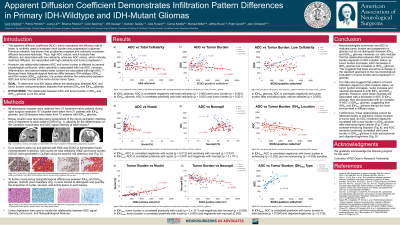Apparent Diffusion Coefficient Distinguishes Primary IDH-Mutated From IDH-Wildtype Gliomas
Apparent Diffusion Coefficient Distinguishes Primary Idh-mutated from Idh-wildtype Gliomas
Friday, April 21, 2023

.jpg)
Cole Chokran (he/him/his)
Medical Student
Columbia University Vagelos College of Physicians & Surgeons
New York, New York, United States
ePoster Presenter(s)
Introduction: Diffusion-weighted imaging is routinely used to evaluate tumor burden in glioma. However, the relationship between tumor burden and the apparent diffusion coefficient (ADC) is affected by several physiological confounds. In particular, IDH-mutated (IDHmut) gliomas have lower tumor cellularity than IDH-wildtype (IDHwt) gliomas, and it is unclear to what extent low ADC indicates tumor burden across tumor types. Furthermore, IDHwt gliomas have greater necrosis and disruption of the blood-brain barrier, which increases edema-related water content, resulting in elevated ADC levels. To determine how IDH mutation status affects the relationship between tumor burden and ADC, we used MRI-localized biopsies obtained from primary IDHmut and IDHwt gliomas.
Methods: Seventy-seven stereotactic biopsies were obtained during open surgical resection from twenty-nine treatment-naïve patients: twenty-two biopsies were taken from nine patients with primary IDHmut gliomas, and fifty-five biopsies were taken from twenty patients with primary IDHwt gliomas. All patients received standard-of-care preoperative imaging, including ADC. For each biopsy, signal intensity for ADC was compared to counts of total cellularity (H&E), tumor cellularity (Sox2), cellular proliferation (Ki67), inflammation (CD68), and neuronal density (NeuN).
Results: ADC is directly related to tumor cellularity in IDHmut gliomas (Sox2, p = 5 x 10e-4) but inversely related to tumor cellularity in IDHwt gliomas (Sox2, p = 0.020). Similarly, ADC is directly related to total cellularity in IDHmut gliomas (H&E, p = 2 x 10e-4) but inversely related to total cellularity in IDHwt gliomas (H&E, p = 0.016).
Conclusion : The relationship between ADC and tumor cellularity in gliomas is highly dependent on IDH mutation status. This finding suggests that IDH mutation status is an important variable for neuroradiological diagnosis.
Methods: Seventy-seven stereotactic biopsies were obtained during open surgical resection from twenty-nine treatment-naïve patients: twenty-two biopsies were taken from nine patients with primary IDHmut gliomas, and fifty-five biopsies were taken from twenty patients with primary IDHwt gliomas. All patients received standard-of-care preoperative imaging, including ADC. For each biopsy, signal intensity for ADC was compared to counts of total cellularity (H&E), tumor cellularity (Sox2), cellular proliferation (Ki67), inflammation (CD68), and neuronal density (NeuN).
Results: ADC is directly related to tumor cellularity in IDHmut gliomas (Sox2, p = 5 x 10e-4) but inversely related to tumor cellularity in IDHwt gliomas (Sox2, p = 0.020). Similarly, ADC is directly related to total cellularity in IDHmut gliomas (H&E, p = 2 x 10e-4) but inversely related to total cellularity in IDHwt gliomas (H&E, p = 0.016).
Conclusion : The relationship between ADC and tumor cellularity in gliomas is highly dependent on IDH mutation status. This finding suggests that IDH mutation status is an important variable for neuroradiological diagnosis.
